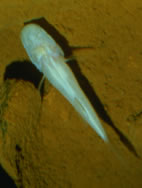| Alabama cavefish | |
|---|---|

| |
| Scientific classification | |
| Domain: | Eukaryota |
| Kingdom: | Animalia |
| Phylum: | Chordata |
| Class: | Actinopterygii |
| Order: | Percopsiformes |
| Family: | Amblyopsidae |
| Genus: | Speoplatyrhinus J. E. Cooper & Kuehne, 1974 |
| Species: | S. poulsoni
|
| Binomial name | |
| Speoplatyrhinus poulsoni J. E. Cooper & Kuehne, 1974[5]
| |

| |
| The range of the Alabama cavefish | |
The Alabama cavefish (Speoplatyrhinus poulsoni) is a critically endangered species of amblyopsid cavefish found only in underground pools in Key Cave, located in northwestern Alabama, United States in the Key Cave National Wildlife Refuge.[6] It was discovered underneath a colony of gray bats in 1967 by researchers Robert A. Kuehne and John E. Cooper[7] and scientifically described in 1974.[8]
On any single visit to the cave, no more than 10 individuals of this fish have been observed, and scientists estimate fewer than 100 are left.[7] This species of fish is believed to be the rarest species of cavefish in the United States and one of the rarest of all freshwater fish, as researchers have failed to find the fish in any other location.[1][7] The Alabama cavefish exists in a fragile ecosystem based on nutrient-rich guano of the gray bat.[9]
Little is known of the reproductive habits and life history of the Alabama cavefish. However, researchers agree that the flooding of the cave triggers a hormonal change in the cavefish, prompting the fish to begin the reproductive cycle.[10] Thus, variations in the frequency of the cave flooding negatively affect the survival of the species.[10]
Unfortunately, the Alabama cavefish is in danger of extinction, according to both the ESA and IUCN listings.[1][11] Conservation measures that have been taken to save the species from extinction include protecting the fish under the Lacey Act and limiting human disturbance of Key Cave, the species' critical habitat.[7][10]
- ^ a b c NatureServe (2013). "Speoplatyrhinus poulsoni". IUCN Red List of Threatened Species. 2013: e.T20467A19033986. doi:10.2305/IUCN.UK.2013-1.RLTS.T20467A19033986.en. Retrieved 19 November 2021.
- ^ "Alabama cavefish (Speoplatyrhinus poulsoni)". Environmental Conservation Online System. U.S. Fish & Wildlife Service. Retrieved 13 April 2023.
- ^ 42 FR 45526
- ^ 53 FR 37968
- ^ "Speoplatyrhinus poulsoni". Integrated Taxonomic Information System. Retrieved 18 April 2006.
- ^ Froese, Rainer; Pauly, Daniel (eds.). "Speoplatyrhinus poulsoni". FishBase. March 2006 version.
- ^ a b c d Romero, Aldemaro (1998). "Threatened fishes of the world: Speoplatyrhinus poulsoni". Environmental Biology of Fishes. 53 (3): 293–294. doi:10.1023/A:1007405815580. S2CID 2960877.
- ^ Cooper, J.E., and R.A. Kuehne (1974). "Speoplatyrhinus poulsoni, a New Genus and Species of Subterranean Fish from Alabama." Copeia 1974: 486-93. doi: 10.2307/1442539
- ^ "Alabama Cavefish". U.S. Fish and Wildlife Service. Archived from the original on 7 October 2014. Retrieved 12 October 2011.
- ^ a b c Cite error: The named reference
:7was invoked but never defined (see the help page). - ^ Cite error: The named reference
:1was invoked but never defined (see the help page).

